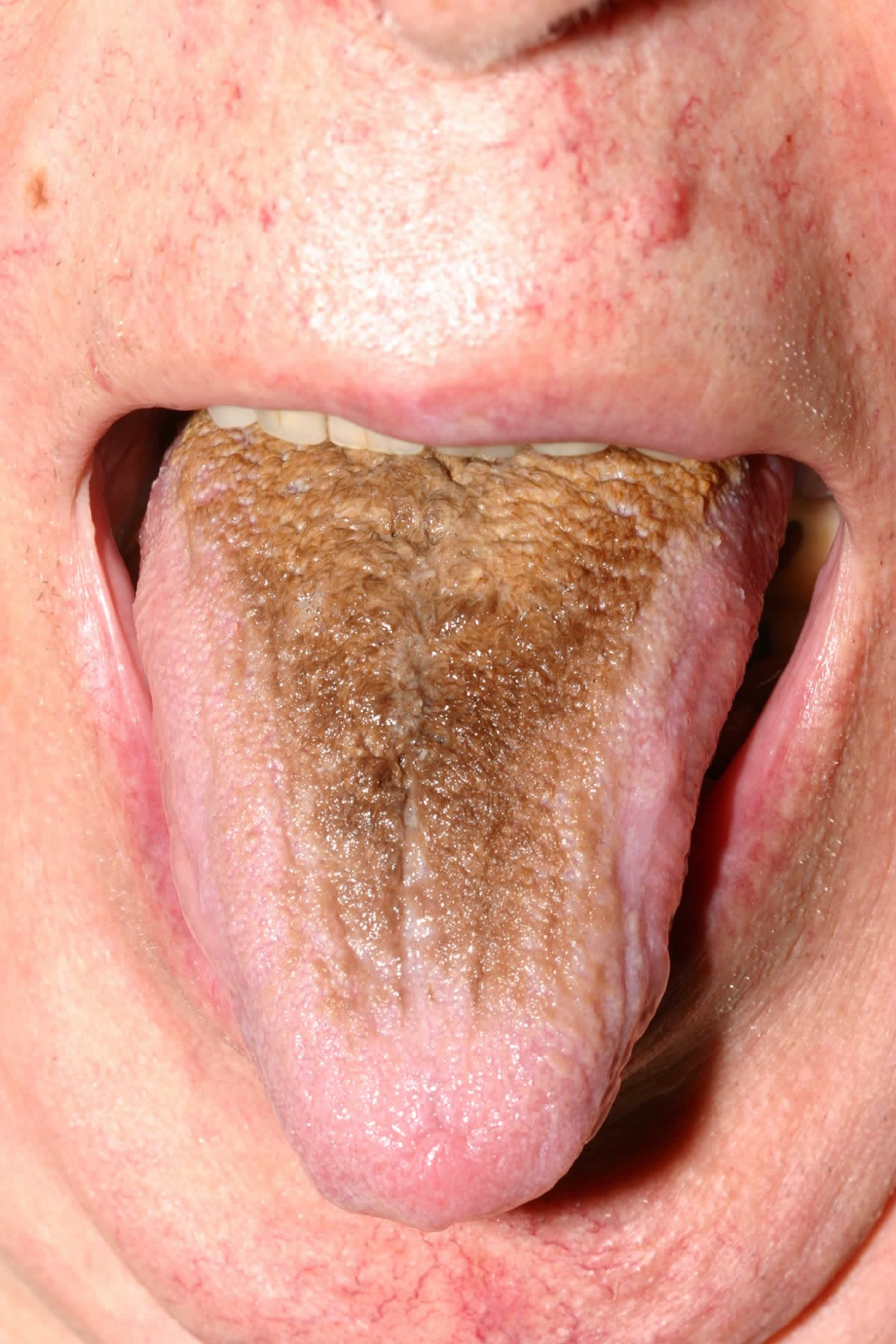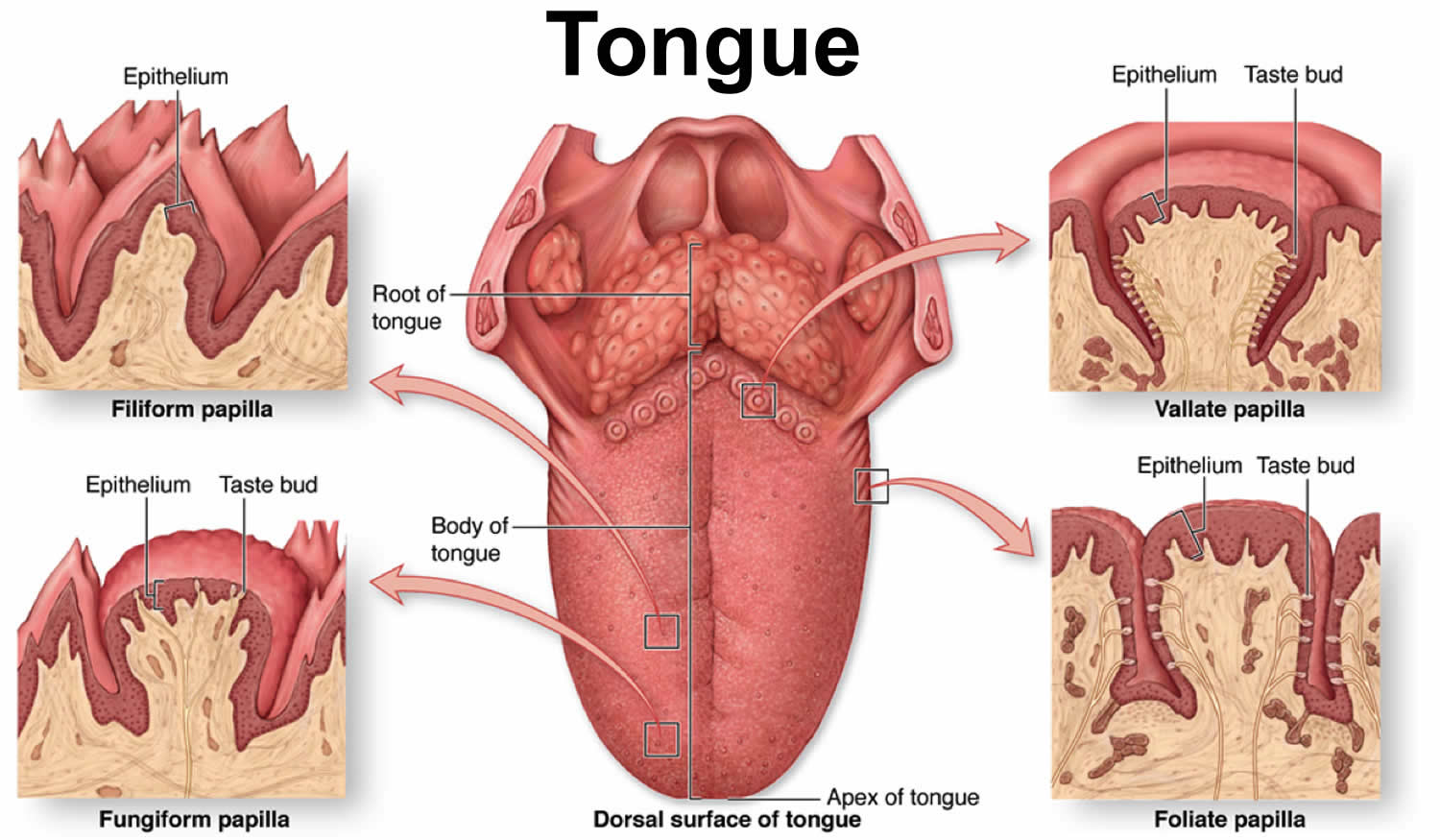What is black tongue
Black hairy tongue also known as black tongue or lingua villosa nigra, is a harmless and temporary discoloration of the upper surface of your tongue. Excessively long filiform papillae are black in color due to accumulation of keratin and chromogenic microorganisms. The filiform papillae are tiny conical bumps found on the surface of the front two-thirds of the tongue that do not carry taste buds (see Figure 2). These filiform papillae, which are longer than normal, can easily trap and be stained by bacteria, yeast, tobacco, food or other substances. The distinct look usually results from a buildup of dead skin cells on the many tiny projections (papillae) on the surface of the tongue that contain taste buds.
The filiform papillae can grow up to 18 mm in length—a ‘hairy’ appearance 1. The tongue becomes discolored, usually brown or black, although brown, yellow and green have also been described 2. The back surface of the tongue is usually affected, and the tip and sides of the tongue are often spared 1.
Hairy tongue is usually asymptomatic and the main problem is its unsightly appearance. Occasionally patients may complain of a burning or tickling sensation on the tongue, nausea, or halitosis (bad breath).
- The condition usually occurs in older individuals but infants as young as 2 months of age may be affected 3.
- Some oral antibiotics can precipitate a black, hairy tongue by altering the microflora of the oral mucosa.
- Taking bismuth subsalicylate (Pepto-Bismol) can induce it as well.
Although black hairy tongue may look alarming, typically it doesn’t cause any health problems, and it’s usually painless. Black hairy tongue usually resolves by eliminating possible causes or contributing factors and practicing good oral hygiene.
See your doctor if:
- You’re concerned about the appearance of your tongue
- Black hairy tongue persists despite brushing your teeth and tongue twice daily
Hairy tongue is usually harmless and self-limiting. If desired, treatment options include:
- Discontinuing responsible drugs
- Avoiding smoking and excessive alcohol intake
- Encouraging good oral hygiene
- Gentle tongue debridement, with a tongue scraper or soft toothbrush and solution containing 3% hydrogen peroxide or baking soda [1]
- Antiseptic mouthwash
- Topical antifungal agent for oral Candida albicans if present
- Topical retinoid
Figure 1. Black tongue
Figure 2. Tongue anatomy
What does it mean when your tongue is black
Black hairy tongue, also known as lingua villosa nigra, is a painless, benign condition characterized by an abnormal brownish–black coating of the dorsal surface of the tongue. Although its exact pathogenesis is unclear, it is thought to be related to defective desquamation and reactive hypertrophy of the filiform papillae.1 Symptoms may include nausea, halitosis and alterations in taste. Black hairy tongue usually appears in people over age 40 years with a history of poor oral hygiene, smoking and antibiotic use. Black hairy tongue has also been reported following stem cell transplantation. Black hairy tongue is uncommon in infants 4.
Who gets black hairy tongue?
Hairy tongue most often occurs in adults over 40 years of age and is rare in infants.1
A range of medications have been linked to hairy tongue including penicillin, erythromycin, tetracycline, doxycycline, lansoprazole, olanzapine, bismuth,1 erlotini,2 linezolid.3
Other factors that may cause, and/or aggravate hairy tongue include:
poor oral hygiene
smoking or chewing tobacco
drinking alcohol
cocaine
peroxidase-containing mouthwash
coloured beverages, including coffee
dehydration
hyposalivation (dry mouth)
radiation therapy.3
Black tongue symptoms
Signs and symptoms of black hairy tongue include:
- Black discoloration of the tongue, although the color may be brown, tan, green, yellow or white
- A hairy or furry appearance of the tongue
- Altered taste or metallic taste in your mouth
- Bad breath (halitosis)
- Gagging or tickling sensation, if the overgrowth of the papillae is excessive
What causes a black tongue
Black hairy tongue typically results when projections on the tongue called papillae grow longer because they don’t shed dead skin cells like normal. This makes the tongue look hairy. Debris, bacteria or other organisms can collect on the papillae and result in discoloration.
Although the cause of black hairy tongue can’t always be determined, possible causes or contributing factors include:
- Changes in the normal bacteria or yeast content of the mouth after antibiotic use
- Poor oral hygiene
- Dry mouth (xerostomia)
- Regular use of mouthwashes containing irritating oxidizing agents, such as peroxide
- Tobacco use
- Drinking excessive amounts of coffee or black tea
- Excessive alcohol use
- Eating a soft diet that doesn’t help to rub dead skin cells from your tongue
Black tongue diagnosis
Diagnosis of black hairy tongue is based on appearance and possible causes or contributing factors. It also includes eliminating other conditions that may cause a similar appearance to the tongue, such as:
- Normal variations in tongue color (pigment)
- Foods or medications that have stained the tongue
- Fungal or viral infections
- Oral lesions that occur on the tongue, such as oral hairy leukoplakia
- Blackened tongue (pseudo-black hairy tongue) from using products containing bismuth, such as Pepto-Bismol
How to get rid of black tongue
Black hairy tongue typically doesn’t require medical treatment. Though unattractive, it’s a temporary, harmless condition.
Practicing good oral hygiene and eliminating factors that may contribute to the condition — such as avoiding tobacco use or irritating mouthwashes — help resolve black hairy tongue. Be sure to talk to your doctor or dentist before stopping a prescribed medication.
If an oral antibiotic precipitated the condition, the condition may remit once the antibiotic is stopped. Increasing the frequency of brushing may help. Brushing the tongue after application of benzoyl peroxide 1-2%, papain (meat tenderizer) or tretinoin gel has been recommended.
If other treatment fails, trimming papillae by carbon dioxide laser burning and electrodessication have been described 2.
For infants, no treatment is recommended as it usually remits spontaneously within a month or two.
To practice good oral health and to remove the tongue discoloration:
- Brush your tongue. Give your tongue a gentle brushing whenever you brush your teeth to remove dead cells, bacteria and food debris. Use a soft-bristled toothbrush or a flexible tongue scraper.
- Brush after eating. Brush your teeth at least twice a day and ideally after every meal, using fluoride toothpaste.
- Floss at least once a day. Proper flossing removes food particles and plaque from between your teeth.
- Visit your dentist regularly. Get professional teeth cleanings and regular oral exams, which can help your dentist prevent problems or spot them early. Your dentist can recommend a schedule for you.
- Maintain good nutrition. Drink plenty of water and eat a balanced diet that contains fresh fruits and vegetables.
- Manabe M, Lim HW, Winzer M, Loomis CA. Architectural organization of filiform papillae in normal and black hairy tongue epithelium: dissection of differentiation pathways in a complex human epithelium according to their patterns of keratin expression. Arch Dermatol. 1999 Feb;135(2):177-81 https://jamanetwork.com/journals/jamadermatology/fullarticle/477720
- McGrath EE, Bardsley P, Basran G. Black hairy tongue: what is your call? CMAJ. 2008 Apr 22;178(9):1137-8. doi: 10.1503/cmaj.071611 https://www.ncbi.nlm.nih.gov/pmc/articles/PMC2292769/
- Körber A, Voshege N. Black hairy tongue in an infant. CMAJ : Canadian Medical Association Journal. 2012;184(1):68. doi:10.1503/cmaj.111013. https://www.ncbi.nlm.nih.gov/pmc/articles/PMC3255199/
- Black hairy tongue in a 2-month-old infant. Poulopoulos AK, Antoniades DZ, Epivatianos A, Grivea IN, Syrogiannopoulos GA. J Paediatr Child Health. 2008 Jun; 44(6):377-9.







